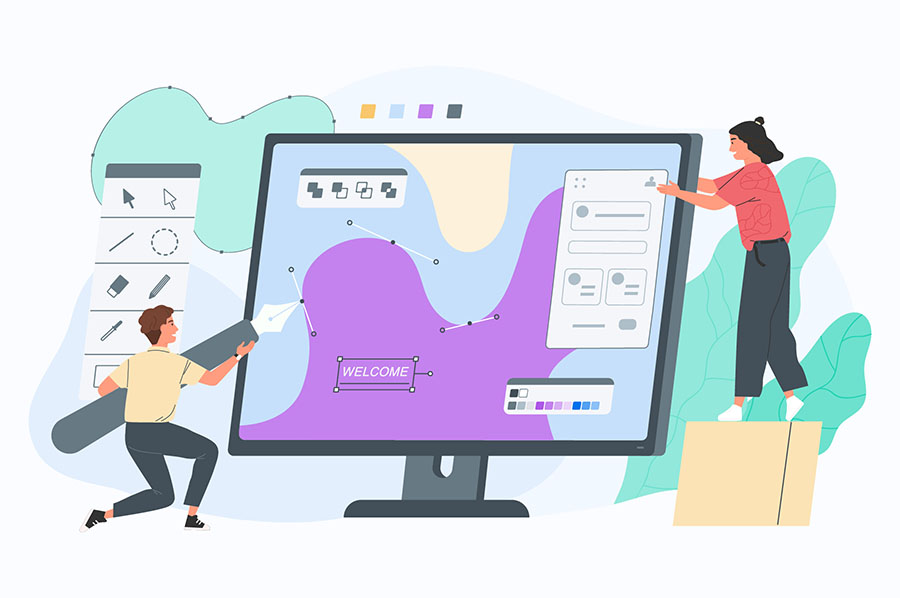A Comprehensive Overview to Finest Practices in Website Design for Improved Customer Experience
In the world of web design, comprehending user needs is critical for developing reliable electronic experiences. A well-structured approach that highlights responsive style, instinctive navigation, and a solid visual power structure can substantially boost customer interaction.
Recognizing Individual Demands
Understanding customer needs is basic to effective website design, as it directly influences individual experience and engagement. A thorough understanding of target market allows developers to create web sites that resonate with individuals, fostering a sense of connection and fulfillment (Web design agency). To attain this, designers have to involve in user research study, using techniques such as surveys, interviews, and functionality screening. This information collection provides insights into individual choices, behaviors, and pain points.

Importance of Responsive Design
Responsive layout is crucial in today's electronic landscape, where individuals access websites throughout a myriad of gadgets with varying display sizes. As mobile phone use continues to increase, making sure that a website supplies an optimal viewing experience on smartphones, tablets, and desktop computers is important. A responsive layout adapts the layout and material based on the user's tool, permitting smooth navigating and readability.
A receptive internet site can improve presence, leading to raised website traffic and customer engagement. Additionally, a constant individual experience throughout devices develops brand name integrity and promotes individual loyalty.
Furthermore, implementing receptive style can result in decreased growth and upkeep prices. Instead of developing several variations of a web site for numerous devices, a single receptive website simplifies updates and content monitoring. This efficiency not only conserves time however also ensures that individuals get the most current details no matter of how they access the website.
Simplifying Navigation

To attain simplified navigating, web designers must prioritize a logical pecking order of web content. Using detailed labels for food selection items can aid individuals understand the objective of each section at a look. Additionally, decreasing the number of menu things decreases cognitive lots, allowing customers to concentrate on one of the most crucial aspects of the site.
Including a search function is additionally useful, as it provides users with a direct path to particular web content. Additionally, making certain that navigation components are constant throughout the site promotes knowledge and simplicity of usage. Responsive layout concepts ought see this site to also be related to navigating menus, ensuring they operate smoothly across all gadgets. Ultimately, simplified navigation not just enhances user satisfaction but also contributes to accomplishing more comprehensive business objectives by raising conversion rates and lowering bounce rates.
Enhancing Visual Hierarchy
Exactly how can designers create a visual pecking order that guides customers via content seamlessly? The answer lies in the strategic use design components that route focus and assist in comprehension - Web design agency. Establishing a clear visual pecking order starts with the reliable application of size, shade, and comparison. Bigger components naturally attract the eye, making them suitable for headlines and key messages. Integrating a consistent color combination can even more enhance focus, as different colors highlight crucial information while keeping a natural visual.
Additionally, the use of whitespace is important in creating try here breathing space around material. This not only stops frustrating the individual however also emphasizes crucial elements, making them stick out. Typography also plays a considerable function; utilizing differing typeface weights and designs can set apart in between key and additional details efficiently.
In enhancement to these strategies, visual hints such as arrows or icons can assist users via the user interface, reinforcing the designated flow of information. By attentively incorporating these components, designers can develop an engaging aesthetic hierarchy that boosts customer experience, making certain that crucial content is easily obtainable and comprehended. This cautious orchestration of layout components inevitably cultivates a much more intuitive communication with the internet site.
Maximizing Page Load Speed
In the hectic digital landscape, optimizing page tons speed has actually ended up being an essential consider individual fulfillment and retention. Study indicates that users expect internet pages to fill within two secs; any type of delay yet limit can result in raised bounce prices and decreased conversion chances.
To enhance load speed, beginning by lessening HTTP requests, as each request includes in the filling time. Utilize methods such as CSS sprites to incorporate multiple pictures into one, lowering the variety of requests. Maximizing pictures with compression and the use of contemporary styles like WebP can dramatically lower documents sizes without endangering top quality.
Applying internet browser caching additionally plays a crucial duty in improving web page speed. By keeping frequently accessed reference data in your area on a customer's device, succeeding gos to can fill almost instantaneously. Furthermore, consider leveraging Content Shipment Networks (CDNs) to distribute content closer to customers, decreasing latency.
Verdict
In conclusion, efficient internet design focuses on customer requirements via meticulous research, promoting instinctive and responsive user interfaces. Ultimately, a commitment to these concepts is important for establishing effective digital experiences that satisfy the advancing expectations of individuals in a competitive on-line landscape.